Slide 70
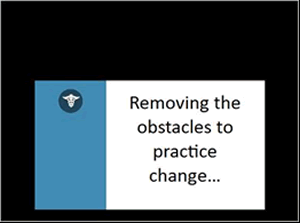
Removing the obstacles to practice change...
Obstacles
Removing the obstacles to real practice change includes addressing misconceptions, using established guidelines, changing culture, advocating from within, improving training and communication, standardizing handoffs, and documenting protocols.
Slide 71
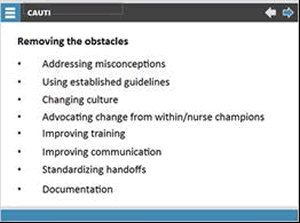
Removing the obstacles
- Addressing misconceptions
- Using established guidelines
- Changing culture
- Advocating change from within/nurse champions
- Improving training, Improving communication
- Standardizing handoffs
- Documentation
Slide 72
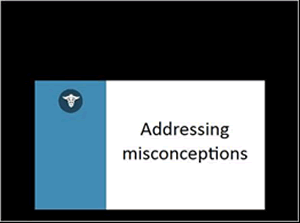
Addressing misconceptions
Misconceptions Addressed
Traditional reasons for catheter placement may seem logical, but many are not.
- A catheter facilitates intake and output (I &O) measurement. In the critically ill patient, a urinary catheter may indeed be indicated. But accurate I & O measurement can be accomplished in many patients with less invasive measurement methods.
- We traditionally thought that a catheter was helpful in preventing falls because patients didn’t have to get up to the bathroom. However, the catheter doesn’t eliminate the urge to urinate, and tubing can actually contribute to tripping and falling in the patient who may be confused and tries to get up.
- We thought that catheterization would protect the skin in the incontinent patient. While a catheter may prove useful in advanced-stage pressure ulcers, there are many other products that can create a barrier to protect intact skin. Additionally, the presence of a catheter can cause pressure and may damage fragile tissue.
- Finally, we thought having patients catheterized would save time, but clearly, with extended lengths of stay, infection complications, and other risks, this intervention ultimately consumes both time and resources.
Slide 73
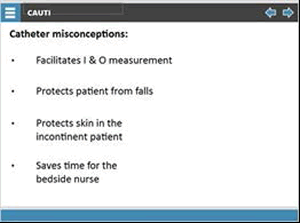
Catheter misperceptions:
- Facilitates I&O measurement
- Protects patient from falls
- Protects skin in the incontinent patient
- Saves time for the bedside nurse
Slide 74
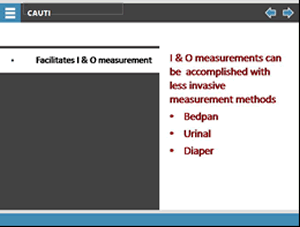
- Facilitates I&O measurement:
- I&O measurements can be accomplished with less invasive measurement methods:
- Bedpan
- Urinal
- Diaper
- I&O measurements can be accomplished with less invasive measurement methods:
Slide 75
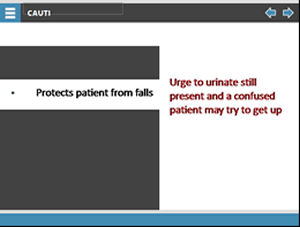
Protects patient from falls:
Urge to urinate still present and a confused patient may try to get up
Slide 76
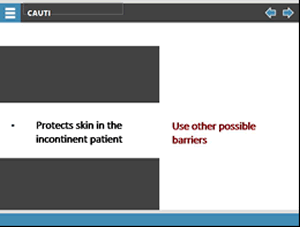
Protects skin in the incontinent patient
Use other possible barriers.
Slide 77
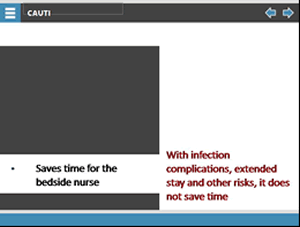
Saves time for the bedside nurse:
With infection complications, extended stay and other risks, it does not save time.
Indications
Select "Start" to reveal indications for indwelling catheter use. Drag each indication into the correctly labeled rectangle. Select "Submit" when you have finished. Selecting the incorrect answer will result in the indication returning to the top of the screen.
Slide 78
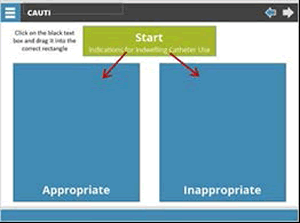
Select the black text box and drag it into the correct rectangle. Box labeled Start: Indications for Indwelling catheter use, with arrows pointing to two blue boxes, one labeled appropriate and one labeled inappropriate.
| Drag Item | Drop Target |
|---|---|
| Obtain urine culture in patients able to voluntarily void | inappropriate |
| Accurate, frequent urinary output monitoring in critical illness | appropriate |
| Patients who have acute urinary retention or bladder outlet obstruction | appropriate |
| Prolonged immobilization (e.g., unstable thoracic or lumbar spine, unstable pelvic fracture) | appropriate |
| Promote healing of open sacral or perineal wounds in incontinent patients | appropriate |
| To promote hygiene in incontinent patients | inappropriate |
Slide 79
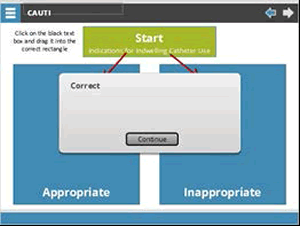
Select the black text box and drag it into the correct rectangle. Box labeled Start: Indications for Indwelling catheter use, with arrows pointing to two blue boxes, one labeled appropriate and one labeled inappropriate.
Dialogue box for correct answer and "continue" button.
Slide 80
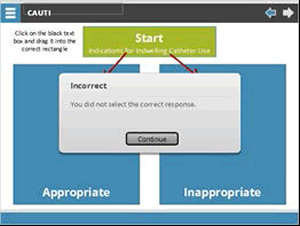
Select the black text box and drag it into the correct rectangle. Box labeled Start: Indications for Indwelling catheter use, with arrows pointing to two blue boxes, one labeled appropriate and one labeled inappropriate.
Dialogue box showing "Incorrect, You did not select the correct response," with "continue" button.
Slide 81

Box labeled Start: Indications for Indwelling catheter use. Two blue boxes, one labeled appropriate and one labeled inappropriate.
Drag Item
| Drag Item | Drop Target |
|---|---|
| Urologic surgery or surgery of the genitourinary tract | appropriate |
| Prone positioning is required | inappropriate |
| Preoperative urinalysis is needed | inappropriate |
| To be admitted to ICU postoperatively | inappropriate |
| Prolonged duration of surgical procedure | appropriate |
| Monitoring of urinary output during surgery | appropriate |
| Large volume of fluid or diuretic use during surgery | appropriate |
Slide 82
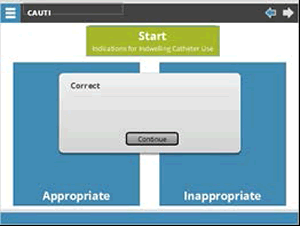
Box labeled Start: Indications for Indwelling catheter use. Two blue boxes, one labeled appropriate and one labeled inappropriate. Dialogue box showing "correct" and "continue" button.
Slide 83
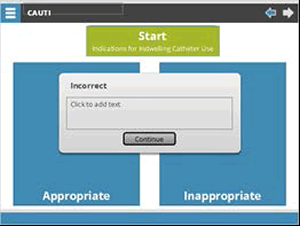
Box labeled Start: Indications for Indwelling catheter use. Two blue boxes, one labeled appropriate and one labeled inappropriate. Dialogue box showing "incorrect," with box to add text, and a "continue" button.
HICPAC
Slide 84
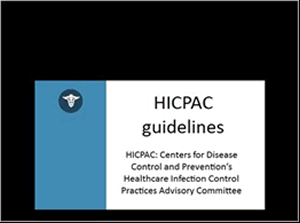
HICPAC guidelines
HICPAC: Centers for Disease Control and Prevention's Healthcare Infection Control Practices Advisory Committee
The Centers for Disease Control and Prevention’s Healthcare Infection Control Practices Advisory Committee, HICPAC, has issued recommendations for the appropriate use of indwelling catheters listed on the screen.
- Critically ill patients
- This does not mean every patient who is admitted to the ICU is critically ill.
- Confirmation of lack of other options for urinary output measurement should be clear and documented.
- The patient with urinary retention or obstruction
- Use a bladder scanner or bedside ultrasound first to identify retention and amount retained.
- To limit exposure, consider straight catheter use instead of an indwelling catheter.\
- The patient who requires immobilization for trauma or surgery
- Inquire about the length of the surgical procedure before catheter placement or communicate with the OR staff to see if they would prefer to place the catheter and remove it immediately after the surgical procedure. If the catheter is placed for the length of the surgical procedure, communication with the PACU nurse will also facilitate prompt removal.
- The patient who is incontinent with open sacral or perineal wounds
- Consult with the wound care specialist to make the best care decision for each patient.
- The patient at the end of life or in hospice care
- Be sure being catheterized is congruent with the patient’s wishes prior to insertion.
- The patient with chronic or existing catheter use
- Some patients may present with a catheter in place, and each one is evaluated for continued use upon arrival.
- Reevaluate the need and discuss with the provider.
Slide 85
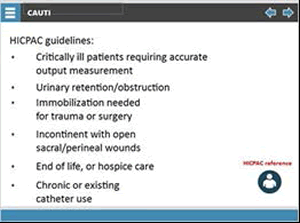
HICPAC guidelines:
- Critically ill patients requiring accurate output measurement.
- Urinary retention/obstruction.
- Immobilization needed for trauma or surgery.
- Incontinent with open sacral/perineal wounds.
- End of life, or hospice care.
- Chronic or existing catheter use.
Slide 86
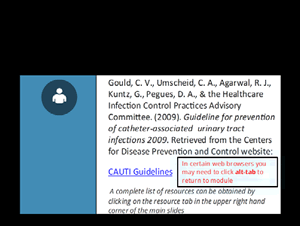
Gould C.V., Umscheid C.A., Agarwal R.J., Kuntz G., Pegues D.A., & the Healthcare Infection Control Practices Advisory Committee (2009). Guideline for Prevention of Catheter-Associated Urinary Tract Infections 2009. Retrieved from the Centers for Disease Control and Prevention. website: CAUTI Guidelines.
A complete list of resources can be obtained by selecting the Resource tab in the upper right hand corner of the main slides.
Slide 87
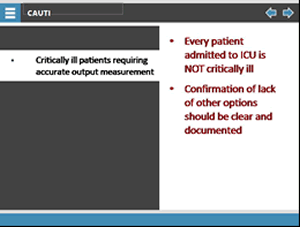
Critically ill patients requiring accurate output measurement.
- Every patient admitted to ICU is not critically ill.
- Confirmation of lack of other options should be clear and documented.
Slide 88
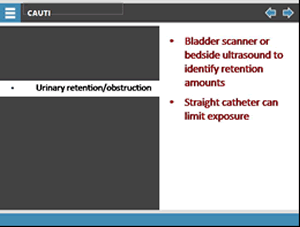
Urinary retention/obstruction:
- Bladder scanner or bedside ultrasound to identify retention amounts.
- Straight catheter can limit exposure.
Slide 89
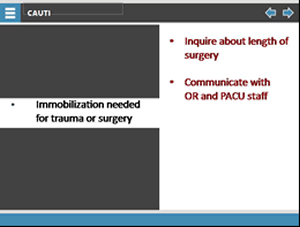
Immobilization needed for trauma or surgery:
- Inquire about length of surgery.
- Communicate with OR and PACU staff.
Slide 90
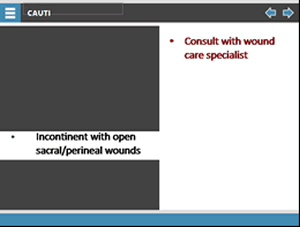
Incontinent with open sacral/perineal wounds:
- Consult with wound care specialist.
Slide 91
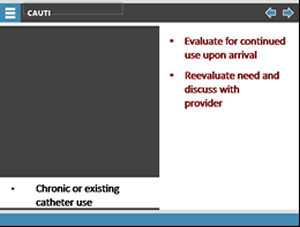
Chronic or existing catheter use:
- Evaluate for continued use upon arrival.
- Reevaluate need and discuss with provider.
Select all inappropriate reasons for use of an indwelling urinary catheter and select "Submit".
Slide 92
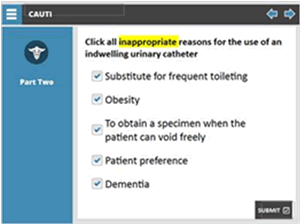
Select all inappropriate reasons for the use of an indwelling urinary catheter:
- Substitute for frequent toileting
- Obesity
- To obtain a specimen when the patient can void freely
- Patient preference
- Dementia
| Correct | Choice |
|---|---|
| X | Substitute for frequent toileting |
| X | Obesity |
| X | To obtain a specimen when the patient can void freely |
| X | Patient preference |
| X | Dementia |
Slide 93
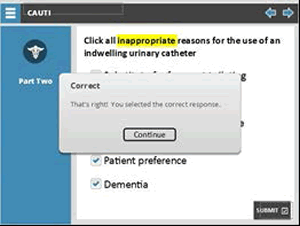
Select all inappropriate reasons for the use of an indwelling urinary catheter:
- Substitute for frequent toileting
- Obesity
- To obtain a specimen when the patient can void freely
- Patient preference
- Dementia
Box showing when correct answer has been selected, and a "Continue" button.
Slide 94
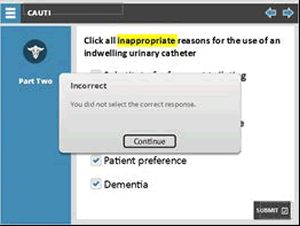
Select all inappropriate reasons for the use of an indwelling urinary catheter:
- Substitute for frequent toileting
- Obesity
- To obtain a specimen when the patient can void freely
- Patient preference
- Dementia
Box showing when an incorrect answer has been selected, and a "Continue" button.
Slide 95
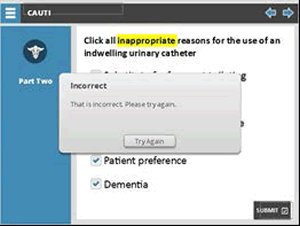
Select all inappropriate reasons for the use of an indwelling urinary catheter:
- Substitute for frequent toileting
- Obesity
- To obtain a specimen when the patient can void freely
- Patient preference
- Dementia
Box showing when an incorrect answer has been selected, and a selection box titled "Try Again."
Inappropriate Reasons
These are all reasons a catheter is not to be used. Many of the contraindications are related to convenience, but a catheter is not to be used merely for the convenience of the staff.
- Catheterization is not a substitute for frequent toileting. Toileting schedules promote continence and the use of a catheter can interfere with that continence training process.
- Obesity can limit movement and the obese patient may require additional staff members to get the patient up to toilet, but a catheter is not a solution for this.
- Even if a catheter is necessary because the patient is unable to provide urine for laboratory analysis, consider the use of a straight catheter for specimen collection.
- There may be patients who will ask for a catheter, but that cannot be the only reason.
- Dementia is a contraindication because catheter placement in the patient with dementia may increase the agitation as confusion worsens with nightfall or illness.
Slide 96
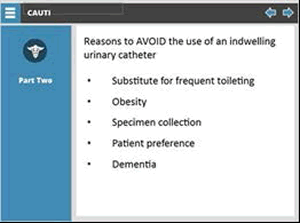
Reasons to avoid the use of an indwelling urinary catheter:
- Substitute for frequent toileting
- Obesity
- To obtain a specimen when the patient can void freely
- Patient preference
- Dementia
Slide 97
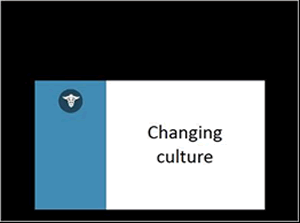
Changing culture
Slide 98
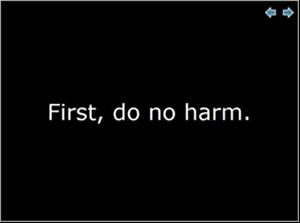
First, do no harm.
Beneficence
Guidelines for appropriate catheter use exist, but the translation of those guidelines to practice has proven difficult. A culture change that shifts from “my work” to “our work” is necessary to underpin this practice change. In addition, implementing these practice changes warrants a focus on the patients so that all decisions are based on what is best for them. Patient-care decision-making is based on the ethical principles of beneficence and non-maleficence. In order to keep the patient safe, the use of urinary catheters has to be condition-driven and continually reevaluated. All obstacles must be removed to make that happen.
Slide 99
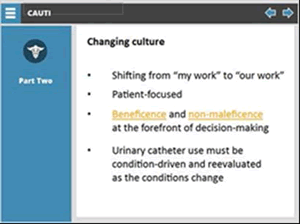
Changing culture
- Shifting from "my work" to "our work,"
- Patient focused,
- Beneficence and non-maleficence at the forefront of decision making
- Urinary catheter use must be condition driven and reevaluated as the conditions change
Slide 100
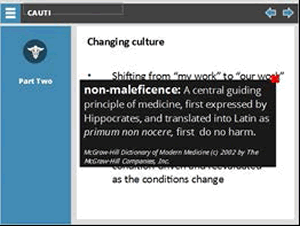
Changing culture
- Shifting from "my work" to "our work,"
- Patient focused,
- Beneficence and non-maleficence at the forefront of decision making
- Urinary catheter use must be condition driven and reevaluated as the conditions change
Covering the list is a black box with white type defining non-maleficence as a central guiding principle of medicine, first expressed by Hippocrates, and translated into Latin as primum no nocere, first do no harm. The source is the McGraw Hill Dictionary of Modern Medicine, 2002, The McGraw-Hill Companies, Inc.
Slide 101
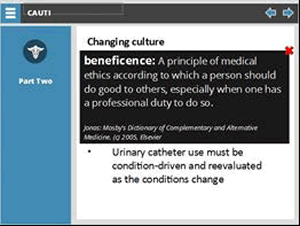
Changing culture
- Shifting from "my work" to "our work,"
- Patient focused,
- Beneficence and non-maleficence at the forefront of decision making
- Urinary catheter use must be condition driven and reevaluated as the conditions change
Covering the list is a black box with white type defining beneficence as a principle of medical ethics according to which a person should do good to others, especially when one has a professional duty to do so. Mosby's Dictionary of Complementary and Alternative Medicine, 2005, Elsevier.
Nurse Champions Survey
Answer the following survey question as it relates to your institution, then select "Submit".
Slide 102
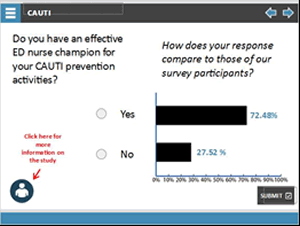
Do you have an effective ED nurse champion for your CAUTI prevention activities?
How does your response compare to those of our survey participants?
Bar chart showing that 72.48% clicked Yes and 27.52% clicked No.
Slide 103
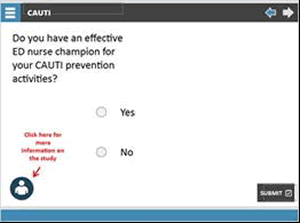
Do you have an effective ED nurse champion for your CAUTI prevention activities?
(Select yes or no)
Slide 104
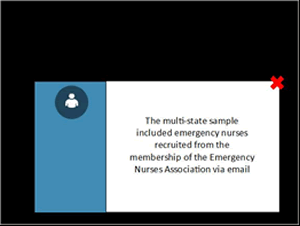
The multistate sample included emergency nurses recruited from the membership of the Emergency Nurses Association via email.



